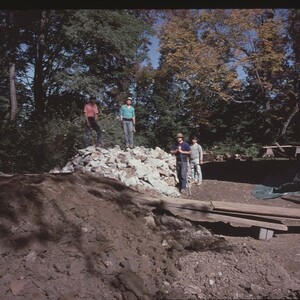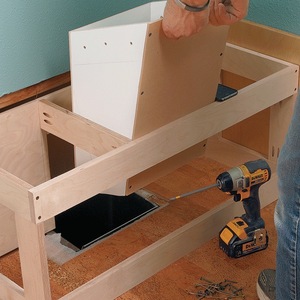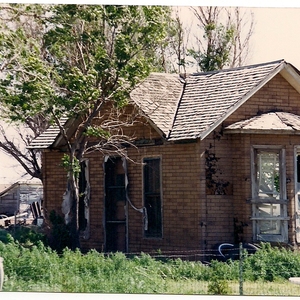The problem is that old and new 2x10s are not exactly the same width, right? So is it more important that the bottom edge rests even on the top plate with the old joist, or that that top edges of the two joists are level against the floor up above.
Also, in a couple of places there is a bit of notching near the top of the joist that has to happen to help accommodate the tub drain. Should we get these new joists attached before or after the plumber replaces all the old pipe?
Thanks in advance!


















Replies
The top to subfloor is what I'd match and shim with steel where it doesn't connect with the plate or girder just like you'd do if there was an error on the girder pocket in the foundation
You could also sister by cutting down larger stock.
Wow, this is really helpful. Thanks, everyone.
I have a "dumb question":
wolf, you suggest using steel for shims. Do they make "steel shims" or what exactly do I ask for by name when I go to the store? I know and understand well the concept of shimming, but have not used steel for my material before.
Thanks again!
The few times I ever needed to do anything like this I've had steel I could use such as 3" fender washers or lolly column plates but if I wanted an exact thickness in one piece I'd use the same place I get my steel from. In my area its Bradford steel or Turner steel. Any welding shop should have it.
Why not just buy larger stock and rip it to what you want.
I'd probably try to put the new joists in place and then shim them up and snug where they bear on the top plate. This should help to reduce any sags in the old floor and tighten everything up.
Notching should be kept to a minimum so if I wasn't doing the plumbing personally I would prefer to install the new joists after the plumber was finished. Whether or not this is practical depends on how the new pipes are to be run. In any event the new holes and notchs will not necessarily correspond to the old ones and it would be simpler to remove the old plumbing before any sistering takes place.
I would sister with 3/4 plywood, glued (PL) and screwed, cut to the precise dimensions and if short, flush more with the bottom than the top - the top of the joist in in compression - the bottom is getting stretched. Ply is stiffer than spruce, and thinner to drill through for the plumber - plus leaves more room between the joists to fit a drill if you don't have a right-angle drill.
I would remove the pipes beforehand that are no longer needed, and drill new holes for the new plumbing as it is installed drilling through the new sisters - otherwise you end up having to cut a slice out of the sister to wrap it around the pipes. Much more damaging to the structure of the sister than a hole. I believe the net result of cutting a hole around the pipe to fit the sister on is equivalent to reducing the size of the sister to virtually the same dimension as its smallest point.
To really do it right, put ply on both sides - your 8' length and then a 5' on one side, and a 5' then an 8' on the other so the joints don't line up. If need be, may want to jack the joist up ever so slightly in the center while gluing, screwing and waiting for the glue to set. I did a 3" thick concrete floor over a 12' 6" span on 2X8s, - same technique, and 5 years later not a crack in the concrete or any movement in the joists.
Good luck !!
Gavin Pitchford
"Sail fast - live slow" (build even slower)
ply would accomplish a lot less too.
Welcome to the Taunton University of Knowledge FHB Campus at Breaktime. where ... Excellence is its own reward!
You lost me...Gavin Pitchford
"Sail fast - live slow" (build even slower)
You might want to first check to see if the existing joist may be adequate. Depending on the additional weight of the tub and the location of the tub within the span of the joist, you may be OK. Eg, if the tub is at or near end of the span, it could very well be OK. If the 2x10 joist are on 16" o.c. and are #2 or btr. SPF or YP, they are good for a span of 15'-5" for 50#/sf live & dead load per my span book for major lumber species. If additional support is necessary, maybe you could add it just at the feet/legs of the tub.
Generally and roughly speaking a notch in the top of a joist will reduce the span of a joist. Eg. a 2" notch in a 2x10 could reduce the span to say a 2x8. Again, it depends where the notch is located. Also, the additional joist do not have to be sistered. They could simply be installed somewhere between the existing joist. This might eliminate the notching of some joist. You might consider headering aroung the tub drain rather than notching.
As to the suggestion of using 3/4' plywood on both sides, Piffin's comment was correct. Only the plys that are parallel to the span can be used/considered when calculating the bending moment/strength of plywood.
ha!, everybody is wrong! ... the joists should rest on the top plates, not tight against the new subfloor. When they dry out they would be below the old, dried, tried and true floor joists. Sister them and only screw the subfloor to the old wood. Since you'll have to remove the existing blocking to sister, make sure you replace it all well, proper blocking btwn joists will stiffen a floor more than anything else ..
<< proper blocking btwn joists will stiffen a floor more than anything else .. >>
I don't think proper blocking is going to stiffen a floor more than anything else...sistering, just as one example, would do more. Justin Fink - FHB Editorial
let me rephrase, after sistering the next most important thing to do is blocking .. there, now we're all wrong, :)
I appreciate that the ply's parallel to the load are the most important, but those perpendicular provide some resistance as well. When I did the work in a similar situation, the architect-engineer I consulted suggested that proper blocking was as least as important as the sistering, because as he pointed out, once a joist develops any kind of a "wow" or a curve in it, strength is substantially reduced - and the wow gets worse.The point to what I did with the ply was that plywood simply doesn't bend until it reaches the point of catastrophic failure. Unlikely here. I have undersized joists (true 2X8s, that should be 10s - but 1890 house.. who knew...) and that had a sag in them after 110 years of use, and that now - once I sistered them with 5.5" ply either side (~5 years ago) , and supported them temporarily while doing so, have substantially less to none - despite the fact that each joist now supports a 3" thick concrete floor with pipes for radiant running through it. I also blocked, but the concrete is formed around the top of the joists and is countersunk between them for 2" so I don't think is going anywhere...I look at the joists in the house that were previously sistered (110 years ago) and they have substantial sag in the middle that I don't believe the plywood will show 100 years from now.Point being that if that worked so effectively for concrete load guaranteed more than the tub, it should work pretty well for a tub.
Gavin Pitchford
"Sail fast - live slow" (build even slower)